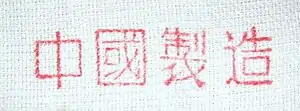Made in China
Made in China, Product of China or sometimes Made in PRC (simplified Chinese: 中国制造; traditional Chinese: 中國製造; pinyin: Zhōngguó zhìzào) is a country of origin label affixed to products manufactured in the People's Republic of China.[1][2]


The Made in China label is the most recognizable label in the world today, due to the country being the largest exporter in the world.[3]
Branding
The "Made in China" brand was historically challenged by the US Cold War media campaigns that reported negatively on the brand and publicized hearings on the security of Chinese products in the United States Congress.[4] Conversely, some advertising companies and the American Chamber of Commerce in Shanghai have since the late 1990s endeavored to shed the Made in China brand of its cheap image, as Made in Japan has done.[4]
Major incidents related to exported products
In the 2007 Chinese export recalls, for example, product safety institutions in the United States, Canada, the European Union, Australia and New Zealand issued recalls and import bans on a wide range of Chinese-made consumer goods, such as pet food, toys,[5] toothpaste,[6][7] lipstick, and certain types of seafood.
During the 2008 Chinese export recalls, heparin was recalled by the U.S. Food and Drug Administration (FDA) due to contamination of the raw heparin stock imported from China.[8][9][10]
Lenovo has admitted in a public statement that it had pre-installed third-party adware named Superfish that was considered malicious on an unknown number of machines, beginning from 2010.[11][12][13]
During the COVID-19 pandemic, rapid antibody tests purchased by Spain for the SARS-CoV2 coronavirus reportedly detected only 30% of infected cases. An 80% detection rate was considered desirable. The tests were allegedly made by a firm which did not have permission to produce biomedical materials, and were inadvertently purchased by Spain due to insufficient oversight owing to the disruption caused by the pandemic.[14]>
Made in China 2025
In 2013, Chinese Premier Li Keqiang and his State Council approved a plan called "Made in China 2025". Drafted by the Ministry of Industry and Information Technology, the plan took one hundred and fifty people over two years to complete. The plan's aim is to improve production efficiency and quality.[15] The "Made In China 2025" initiative is not just aimed at removing dependence on foreign technology, but also to have China actively lead and define international technology standards.[16]
See also
References
- "Fan, Y. (2008) "Country of origin, branding strategy and internationalisation: the case of Chinese piano companies", Journal of Chinese Economic and Business Studies, 6:3, 303-319".
- "Fan, Y. (2006) "The globalisation of Chinese brands", Marketing Intelligence &Planning, 24:4, 365-379".
- Monaghan, Angela (January 10, 2014). "China surpasses US as world's largest trading nation". The Guardian. Retrieved May 17, 2015.
- Jing, Wang. Brand New China: Advertising, Media, and Commercial Culture. Harvard University Press. pp. 136–137.
- "Mattel to recall more Chinese-made toys". CNN. Archived from the original on 17 March 2020. Retrieved 14 August 2007.
- Spain withdraws Chinese toothpaste from the oral care market CosmesticsDesigns.com. 12 July 2007.Accessed: 2007-09-05.
- Ramachandran, Arjun (29 August 2007). "Toxic toothpaste alert: buyers beware". The Sydney Morning Herald. Retrieved 29 August 2007.
- CBS News, Blood-thinning drug under suspicion
- FDA informational page with information and links about FDA investigation.
- "Heparin's Deadly Side Effects". Time magazine. 13 November 2008. Archived from the original on 21 November 2008. Retrieved 2008-11-16.
A month earlier and half a world away, a team of quality-control specialists from Baxter International, the big multinational health-care company (2007 sales: $11.26 billion) based in Deerfield, Ill., arrived in Zhejiang province, China, about two hours by car from Shanghai, to inspect a facility owned by one of its key suppliers. CZ-SPL is a joint venture controlled by Scientific Protein Laboratories LLC (SPL), a Waunakee, Wis., company started in 1976 by Oscar Meyer, of hot-dog fame. (The connection: pigs naturally produce proteins used in pharmaceuticals.) CZ-SPL makes a key ingredient, what in the pharmaceutical business is called an active pharmaceutical ingredient, or API, for a drug called heparin, a blood thinner that is widely used by kidney-dialysis and postsurgical patients to prevent blood clots. The team found little unusual and gave the facility a clean bill of health.
- "LENOVO STATEMENT ON SUPERFISH - Lenovo Newsroom". news.lenovo.com. Archived from the original on 2017-09-13. Retrieved 2015-03-01.
- "Lenovo Superfish Adware Vulnerable to HTTPS Spoofing - US-CERT". www.us-cert.gov.
- "Archived copy". Archived from the original on 2015-03-02. Retrieved 2015-03-01.CS1 maint: archived copy as title (link)
- Jones, Sam. "Coronavirus test kits withdrawn in Spain over poor accuracy rate". The Guardian. Retrieved 4 February 2021.
- "Made in China 2025". Center for Strategic and International Studies. Retrieved 14 July 2015.
- Levine, Derek Adam (2020). "Made in China 2025: China's Strategy for Becoming a Global High-Tech Superpower and its Implications for the U.S. Economy, National Security, and Free Trade". Journal of Strategic Security. 13 (3): 1–16. doi:10.5038/1944-0472.13.3.1833. ISSN 1944-0464.
External links
- Made in China OECD Observer, November 2006.